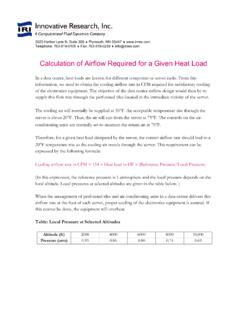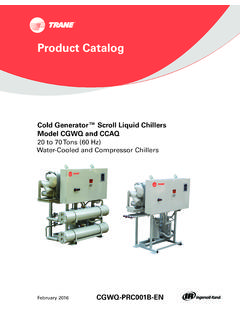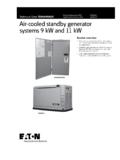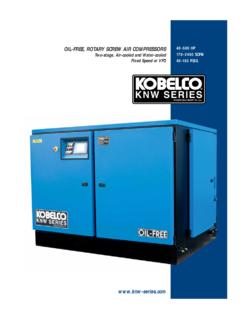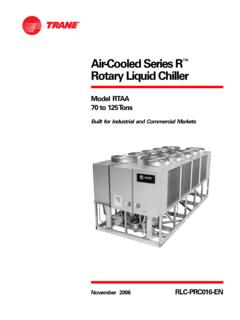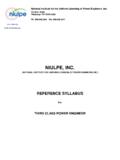Transcription of ANALYSIS AND DESIGN OF LIQUID-COOLING SYSTEMS …
1 1 Copyright 2003 by ASME Proceedings of IPACK03 International Electronic Packaging Technical Conference and Exhibition July 6-11, 2003, Maui, Hawaii, USA InterPack2003-35233 ANALYSIS AND DESIGN OF LIQUID-COOLING SYSTEMS USING FLOW NETWORK MODELING (FNM) Kanchan M. Kelkar Suhas V, Patankar Innovative Research, Inc. Plymouth, MN 55447 ABSTRACT liquid cooling is used for thermal management of electronics in defense, power, medical, and computer applications due to the increasing power density and the desire for compact packaging. The objectives in the DESIGN of these SYSTEMS are to create a sufficient amount of total flow and to appropriately distribute the flow so as to maintain the electronic component temperatures at the desired level.
2 The technique of Flow Network Modeling (FNM) is ideally suited for the ANALYSIS of flow distribution and heat transfer in LIQUID-COOLING SYSTEMS . The FNM technique uses overall flow and thermal characteristics to represent the behavior of individual components. Therefore, solution of conservation equations over the network enables efficient prediction of the flow rates, pressures, and temperatures in a complete LIQUID-COOLING system . This article describes the technical basis of the FNM technique and illustrates its application in the DESIGN of a distributed-flow cold plate and of a complete water-cooled system . The study demonstrates the utility of the FNM technique for rapid and accurate evaluation of different DESIGN options and the ensuing productivity benefits in the DESIGN of liquid cooling SYSTEMS .
3 INTRODUCTION liquid cooling is increasingly used for thermal management of electronics because of the several advantages it offers in the cooling of high-power devices. First, in applications where power densities exceed the limits of air- cooling , liquid cooling is the only practical heat removal mechanism. Second, liquid cooling offers a high-performance cooling solution and results in a compact DESIGN . Further, liquid cooling also offers better control over changes in the heat load and higher reliability. liquid cooling has conventionally been used in defense, power, and medical laser and diagnostic equipment. It is now being considered for the cooling of high-end servers, telecommunication equipment, and automatic test equipment.
4 DESIGN of a LIQUID-COOLING system requires sizing of individual components so that the desired flow is delivered to the cold plates and heat sinks on which the electronics components are mounted. The individual cold plates and heat sinks also need to be designed so as to achieve effective and uniform cooling over the entire surface. This article discusses the utility of the technique of Flow Network Modeling (FNM) for the ANALYSIS of flow and heat transfer in LIQUID-COOLING SYSTEMS and illustrates the productivity benefits that the thermal engineer can derive from its use in the DESIGN process. DESIGN OF LIQUID-COOLING SYSTEMS LIQUID-COOLING SYSTEMS involve circulation of a coolant through a closed loop that contains components for flow distribution (tubes, quick disconnects, three-way and four-way valves, and pumps), flow control (valves and orifices), heat absorption (cold plates and fin stock), and heat removal (heat exchanger).
5 A liquid reservoir is used to maintain the system pressure and compensate for any small leakage that may occur. The coolant loop may also use a filter to remove particulates from the circulating coolant. The DESIGN of the liquid cooling system involves Component-level and system -level DESIGN as discussed below: Component-Level DESIGN A critical component in a LIQUID-COOLING system is the cold plate or the heat sink. The flow distribution within the passages of a cold plate should provide uniform cooling over the entire surface of the cold plate. Similarly, the fin thickness and fin spacing of a heat sink need to be chosen appropriately for obtaining the desired flow rate and heat transfer performance.
6 system -Level DESIGN Most practical cooling SYSTEMS involve various components arranged in a complex manifold. Therefore, primary objectives of the system -level DESIGN are to achieve the total overall flow and to appropriately distribute that flow to individual cold plates so that the temperature of the electronic components is maintained at the desired level. The FNM technique addresses the interaction among the individual parts of a flow system in an efficient manner for determining the resulting flow distribution and thermal performance. Therefore, it is ideally suited for both component-level and system -level DESIGN and ANALYSIS . 2 Copyright 2003 by ASME ANALYSIS USING FLOW NETWORK MODELING The details of the FNM technique have been described in the earlier articles (Belady et al.)
7 [1]). The steps involved in the use of this technique for the ANALYSIS of LIQUID-COOLING SYSTEMS are as follows. Network Representation - The flow system is represented as a network of components ( Orifices, Valves, Tee-junctions, Pumps, Reservoirs, Cold Plates, and Heat Sinks) and flow paths (tubes). Component Characteristics - Each component is characterized by an empirical correlation that relates the pressure drop and heat transfer rate to the corresponding flow rate. The flow characteristics are typically described by the following equation. 2)/(21 AQKp = (1) The loss coefficients for various components can be obtained from handbooks ( Idelchik [2], Blevins [3]), experimental measurements, or a detailed CFD ANALYSIS .
8 For example, flow characteristics of a tube is represented using Moody s chart. The minor loss factor for an orifice is calculated from the ratio of the minimum and the inlet/exit areas. Flow performance of cold plates can be characterized in terms of the variation of the overall pressure drop with the flow rate. The thermal performance of a cold plate or a heat sink is characterized in terms of the variation of thermal resistance with the flow rate. Thermal resistance, in turn, is defined as the difference between the temperature of the electronic component and the inlet coolant temperature required to transfer one unit of power. Another component that is important in the ANALYSIS of liquid cooling SYSTEMS is the Tee-junction.
9 Its loss factors account for the flow inertia so that accurate predictions can be made of the flow distributions in the flow manifolds encountered in LIQUID-COOLING SYSTEMS . Solution of the Equations Each component in the system is represented by a combination of links and nodes. Pressure and temperature are calculated at each node while the flow rates are associated with the links. The flow characteristics of each link, given by Eq. (1), constitute the momentum equations. Mass and energy conservation is imposed at each node of the network. The forms of the discretized momentum and continuity equations are given below. Momentum Equation for a Link RQSppCR+= 21 (3) The quantities SCR and R are determined by linearizing Eq.
10 (1). Thus, R is the slope of p-Q curve. Mass Conservation at a Node 01= =nlQ (4) Here n denotes the total number of links at that node. The calculation of the heat loss/gain in each link in combination with the imposition of energy balance at each node determines the temperature distribution in the network. An efficient method to solve the momentum and mass conservation equations is to use a pressure-based solution algorithm. It involves the following steps. 1. Assume a distribution of flow rates over the links and pressures at the nodes. 2. Calculate the flow rates for the links from the momentum equation using existing nodal pressures.
